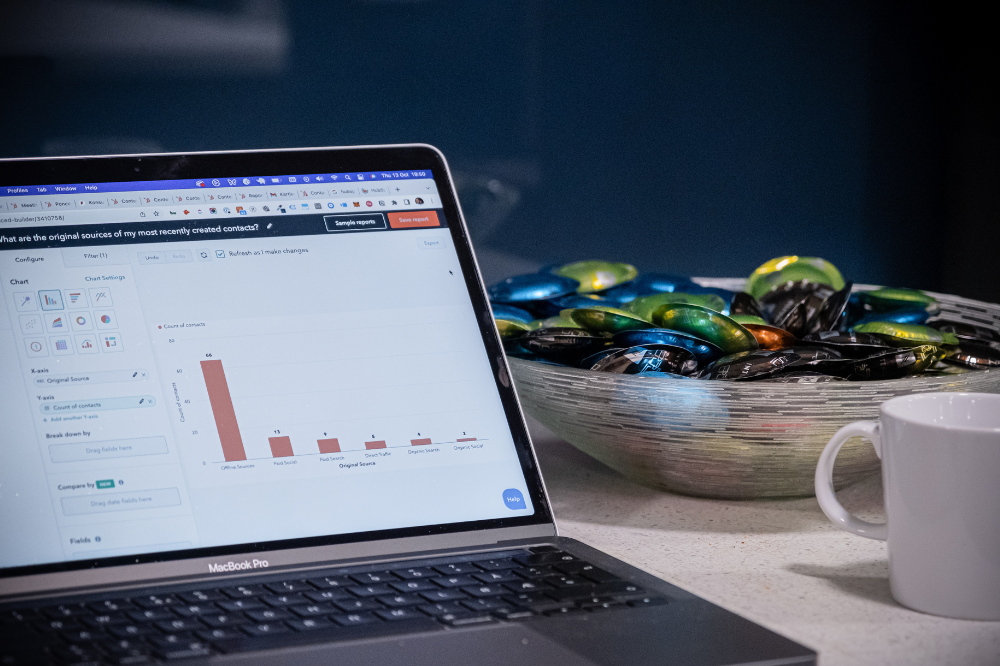Account-Based Marketing (ABM) in HubSpot: A Complete Guide
The Beginners Guide to Account-Based Marketing (ABM) in 2025

Want to stop wasting your marketing budget on leads that never convert?
ABM focuses your sales and marketing on high-value prospects to win bigger deals.
Most businesses spread their sales and marketing efforts too thin.
With Account-Based Marketing (ABM), you focus on high-value accounts (companies) that matter most to your business and have the highest potential financial return.
Unlike traditional marketing, where you cast a wide net and focus on generating leads, ABM zeroes in on key prospects or existing clients with serious revenue potential.
From there, you create tailored campaigns that align with their industry, role, and goals.
It’s less about generic pitches and generating as many leads as possible and more about offering tailored content and solutions that address their unique challenges.
This step-by-step guide shows you exactly how to:
- Build your ideal customer profile to identify perfect-fit accounts
- Create tailored campaigns that convert key decision-makers
- Align your sales and marketing teams for maximum impact
What Makes Account-Based Marketing (ABM) So Effective in B2B?
1. ABM Focuses on Ideal Buyers
ABM begins by identifying and analyzing patterns in your best existing customers:
- Annual revenue
- Annual profit
- Employee count
- Industry code
- Locations
- Technology stack
- Business challenges
- Decision processes
- Growth trajectory
Start by finding accounts that match the traits of your best customers.
Then, build targeted company lists to optimize the ROI of your campaigns.
Instead of sending one-size-fits-all ads and content to a broad list of companies, you concentrate on a carefully chosen list of companies that check all the right boxes.
Once you’ve selected your target accounts, the magic of ABM is in the details.
Every content or cold email is tailored for specific companies and their teams.
2. ABM Brings Sales and Marketing Together
Think of B2B marketing like a relay race. Marketing builds awareness with tailored campaigns, then passes the baton to sales to carry the conversation toward a sale.
Marketing, Sales, and Customer Success collaborate to select target accounts and define success metrics. Customer success ensures value delivery post-sale.
Your prospects are everywhere—LinkedIn, industry blogs, webinars, and even virtual conferences. ABM ensures your message reaches them across all these channels.
For instance, you might run a LinkedIn ad targeting decision-makers, share a helpful article via email, and invite them to an exclusive webinar—all reinforcing the same message.
Using an ABM strategy, marketing qualifies engaged accounts before passing to sales, with customer success managing implementation and expansion opportunities.
3. ABM Doesn’t Rely on Guesswork
With the right tools, you can identify which accounts will likely buy, track their engagement, and time your outreach perfectly.
For example, using buyer intent data solutions like Breeze can reveal when a company is actively researching your solution or checking out competitors.
Learn more: How HubSpot Buyer Intent Data Turns Anonymous Traffic into Revenue →
By layering this information with firmographics (e.g., company size) and technographic (e.g., tools they use) data, you can build a laser-focused list of accounts to focus your efforts.
4. ABM is About Quality Over Quantity
Traditional B2B marketing has been about volume—bringing in as many visitors and leads as possible, then filtering them for quality later. This leads to a lot of resource waste.
With ABM, you flip the funnel.
Instead of starting with a massive pool of leads, you carefully select a list of great-fit accounts and focus on moving them through the sales process.
Traditional campaigns might get 500 leads but few real sales opportunities.
ABM might target just 100 leads, but 30 become high-value accounts worth pursuing.
With traditional inbound and content marketing strategies, you cast a wide net, hoping to attract anyone interested in your product or service.
With ABM, you start with the end in mind—you decide exactly who you want to reach before creating your campaigns.
While traditional marketing might focus on cost per lead (CPL) or the total number of leads, ABM zooms in on account-based metrics like pipeline growth, deal size, or retention rates.
For example, instead of celebrating thousands of form submissions, you’ll celebrate engaging the right executive teams and closing bigger deals.
Even if the volume is smaller, the impact is more significant.
5. ABM Isn’t a Replacement—It’s an Enhancement
One misconception is that ABM replaces your existing marketing strategies.
The truth is that ABM is more like a lens you apply over existing strategies.
Traditional marketing channels like blogs, webinars, and social media remain critical to ABM.
Implementing ABM means your emails, ads, and content aren’t generic—they’re tailored to address the specific goals and challenges of decision-makers in your target accounts.
Content marketing remains valuable. ABM enhances it by personalizing and tailoring content for key accounts instead of going wide in the topics you create content around.
The Three Types of ABM: How Personal Should You Get?
ABM is divided into three tiers based on revenue potential.
One-to-One ABM (Tier 1)
This is the most personalized form of ABM, where a company is treated as a separate market.
Tier 1 accounts warrant fully personalized marketing, from custom content to tailored outreach, given their potential contract values of multiple millions in revenue.
You might build a microsite designed just for them and create a customized case study or whitepaper to show how you can solve their specific problems.
Because it requires time and effort, this approach works best for a small number of accounts, usually 5-10 companies, that could generate massive revenue for your company.
One-to-Few ABM (Tier 2)
Tier 2 accounts, which range from 10 to 100 targets with mid-six- to low-seven-figure contract values, share similar challenges across industries.
For example, maritime technology companies, cruise operators, and port authorities need solutions to meet IMO 2030 emissions targets.
In this example, you could host a focused webinar or event (or both) on IMO 2030 compliance strategies, targeting maritime tech decision-makers across your tier 2 accounts.
This approach lets you create targeted campaigns that resonate with multiple accounts while maintaining some personalization across a cluster of accounts.
One-to-Many ABM (Tier 3)
Tier 3 targets comprise hundreds of accounts with contract values in the low five or six figures.
While personalization is lighter, marketing remains targeted through industry-specific content and semi-customized outreach.
This approach scales efficiently across a broader account base while maintaining better relevance than traditional marketing.
Some typical marketing tactics for tier 3 accounts include a paid social media campaign on LinkedIn or outreach using cold email or LinkedIn.
Although it is not as tailored as other types of ABM, it is still much more focused than traditional mass marketing and can deliver strong results.
Debunking Common Myths About Account-Based Marketing (ABM)
If you’re new to Account-Based Marketing, you might think it’s either the ultimate fix for all marketing challenges or something only big-budget companies can pull off.
Neither is true.
Let’s bust some of the biggest myths about Account-Based Marketing (ABM):
Myth 1: “ABM Replaces Everything Else”
Does ABM mean ditching all your current marketing strategies?
Not at all.
Think of ABM as fine-tuning your existing marketing strategy.
It sharpens how you use paid ads, email marketing, and content creation tools.
When doing ABM, you will still create blog posts and whitepapers or launch paid ads.
ABM helps you focus your efforts without throwing out what already works.
Myth 2: “You Need Big Budgets and Complex Tools”
Are you worried ABM requires fancy software or a massive team?
Good news: you can start small.
Many companies launch effective ABM campaigns using CRM tools like LinkedIn Sales Navigator, email automation, and spreadsheets for planning.
Smaller businesses often excel at ABM because they can focus intensely on a few high-value accounts without needing expensive platforms.
If you want an excellent platform for Account-Based Marketing, HubSpot streamlines ABM execution with list building, pipeline tracking, ad platform integrations, and reporting.
Myth 3: “Everything Must Be Fully Personalized”
The idea that every message must be deeply customized can seem overwhelming, but that’s not true. Personalization works on tiers and revenue potential.
For your top accounts, you might build tailored microsites or one-on-one campaigns.
For lower-priority accounts, referencing their industry trends or common pain points can still feel personal without requiring hours of research. The key is balancing effort with impact.
Myth 4: “You Need a Huge Team to Succeed”
ABM thrives on collaboration, but you don’t need a giant team to pull it off.
Even a small team—like one marketer and one salesperson—can work together to target accounts, craft campaigns, and share insights.
Clear communication and a shared strategy are far more critical than team size.
Myth 5: “ABM Is Just Another Way to Generate Leads”
Think ABM is all about finding new customers?
Account-Based Marketing can be used in many ways besides winning new customers. It can also help you nurture existing relationships, upsell current clients, and keep retention rates high.
Focusing on the entire customer journey—from first contact to renewal—can help you build deeper connections and achieve more sustainable business growth.
Avoid These Common ABM Mistakes
Even with a solid plan, inevitable missteps can derail your ABM efforts.
These are roadblocks that can slow your progress or send you off track.
Let’s break down the most common ABM mistakes and how to avoid them.
Mistake 1: Picking Dream Accounts Without a Strategy
It’s tempting to create a wish list of big-name accounts based on high profile or recent growth.
But without digging into the data—like firmographics, intent signals, and specific business needs—you could waste time on accounts that don’t align with your Ideal Customer Profile (ICP).
Instead, ensure that every account you target has been carefully vetted to ensure that it correctly fits your product or service.
Mistake 2: Skipping the Warm-Up Phase
Jumping straight into pitches without building trust can feel pushy—like cold-calling on steroids.
Warm-up activities, such as sending a LinkedIn connection request with a personalized note, sharing thought leadership content, or inviting prospects to a webinar, can help establish credibility.
Without this phase, your outreach might seem tone-deaf and self-serving.
Mistake 3: Lack of Alignment Between Teams
ABM is all about teamwork.
If sales pursue one set of accounts while marketing targets another, your strategy will feel disjointed, and your prospects will notice.
Schedule regular check-ins between sales and marketing to ensure everyone is on the same page regarding account priorities, messaging, and goals.
For example, weekly syncs to review KPIs and campaign performance can keep everyone on the same page.
Mistake 4: Expecting Immediate Results
B2B sales cycles are long, often involving multiple stakeholders and months of decision-making.
You might write off a working strategy if you judge your ABM success too quickly.
Instead of expecting instant wins, look for early signs of progress, like increased engagement or positive feedback from key accounts. Remember, patience pays off.
Mistake 5: Overlooking the Buying Committee
In B2B, decisions aren’t made by one person—a team makes them.
If your ABM strategy only targets executives, you could miss key influencers, such as the end user who will implement your solution or the finance team reviewing ROI.
Tailor your messaging to address the needs of each role in the buying committee. For instance, a CTO might prioritize scalability, while a CFO will focus on cost-effectiveness.
How to Build a Winning ABM Strategy
Creating an effective ABM strategy isn’t about guesswork or making a wish list of accounts.
It’s a step-by-step process that helps you understand your audience, organize your priorities, and craft messaging that resonates with the people who matter most.
Step 1: Define Your ICP (Ideal Customer Profile)
Your ICP is the foundation of your ABM strategy. It answers the big question: “Which companies are the perfect fit for what we offer?”
Start by analyzing your current customers, especially those who love your product and contribute the most revenue. Ask questions like:
- What made them choose your solution?
- How do they integrate it into their workflows?
- What features do they find most valuable?
You'll likely identify recurring needs and patterns in your customer base.
For example, maritime operators might rely on your solutions for emissions monitoring, while shipyards value your integrations with vessel management systems.
Consider emerging trends like increasing environmental regulations and shifting toward autonomous vessel operations.
How to Make an Ideal Customer Profile (ICP): A Step-by-Step Guide →
Once you’ve gathered this data, create a living document that outlines key criteria, such as:
- Why do they buy from you?
- Industry, company size, and location
- Technology preferences (e.g., platforms they already use)
- Buying cycles and decision-making processes
Step 2: Build Your List of High-Value Target Accounts
Account tiering helps allocate ABM resources effectively across your target companies.
Tier 1 represents your highest-value targets - just 5-10 accounts requiring full customization from tailored content to one-on-one attention.
While resource-intensive, these accounts justify the investment through potential returns.
Tier 2 encompasses 10-100 accounts grouped by shared challenges rather than traditional industry verticals.
These accounts receive semi-customized campaigns that balance personalization with efficiency. For example, maritime technology providers and vessel operators might share concerns about emissions regulations despite operating in different sectors.
Tier 3 includes hundreds of accounts managed through automated but targeted outreach or paid social campaigns.
While personalization is lighter, industry-specific messaging and content ensure campaigns remain relevant. This approach scales well while maintaining a better focus than traditional marketing.
Tools like Clay and Ocean.io help identify target accounts, while LinkedIn Sales Navigator surfaces key contacts.
Regular evaluation helps disqualify accounts that lack budget or have long-term competitor contracts, ensuring resources stay focused on opportunities with the highest potential return.
Step 3: Crafting the Right Message for the Right Audience
Now that you know which accounts to target and how much effort to invest, it’s time to focus on what matters most: your message.
In ABM, generic pitches won’t cut it.
Every message must resonate with your audience's roles, goals, and challenges.
Think about the different people involved in a buying decision:
- A CTO might worry about implementation complexity and security risks.
- A CFO will ask, “What’s the ROI?” or "How much can we save?"
- End-users care about usability and how the solution fits into their daily workflows.
Your job is to speak to each of these concerns directly.
For example, when targeting a CTO, you might emphasize your platform’s scalability and security certifications. For the CFO, you might highlight cost savings and efficiency gains.
The more your message seems like a solution to their problem, the more likely you are to grab their attention.
Your message should reinforce the same core challenges and solutions, whether it’s a LinkedIn ad, an email, or even a physical mailer.
For instance, if your LinkedIn post highlights cost savings, your follow-up email could include a case study that proves it.
Each touchpoint should build on the last, guiding your audience closer to a decision.
Step 4: Warm-Up and Activation Campaigns
Success in ABM starts with warming up accounts before any sales pitch.
Build awareness through LinkedIn engagement, share relevant content, and host industry webinars and events.
For maritime tech companies, this might mean joining discussions about emissions regulations or sharing insights on fleet optimization.
The activation phase converts warm relationships into sales conversations.
Research company updates and pain points to craft targeted messages - like highlighting your emissions monitoring capabilities after a fleet expansion announcement.
Give your sales team clear playbooks for following up on different engagement types, ensuring consistency across all account interactions.
Every touchpoint should feel like a natural progression rather than an abrupt shift to selling.
Focus on demonstrating industry expertise and building genuine relationships before transitioning to more direct sales discussions.
Why ABM Is Worth the Effort
Ready to Launch Your ABM Strategy?
Now, you can target high-value accounts and create tailored campaigns that convert.
Here's how to get started:
1. Pick 5-10 target accounts that are a good fit.
2. Focus on one industry challenge (like emissions compliance).
3. Test a simple campaign combined with an outreach sequence.


